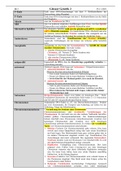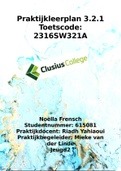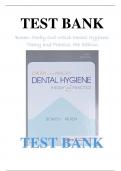BIOANALYSIS
Identification of an unknown protein through
SDS-page - and IEF experiments
Tymo Zwakenberg S4326253
16-06-2023
ABSTRACT
Gel electrophoresis is a widely used technique in protein analysis, employing SDS-PAGE for size
separation and IEF for charge separation. This experiment aimed to determine the identity of an
unknown protein sample through gel electrophoresis experiments. Two gel runs were performed: a
15% resolution gel and a 10% resolution gel. The first run encountered challenges due to
simultaneous usage of the electrophoresis tank, resulting in incomplete migration of the dye front
and overlapping bands. However, this did not impact the final protein identification. The second run,
using a 10% resolution gel, yielded a more precise curve, enabling the determination of the unknown
protein's molecular weight as 60.98 kD. Comparison with the known molecular weight of bovine
serum albumin (66.4 kD) confirmed its identity. In the isoelectric focusing (IEF) experiment, the
obtained IPG strip was considered invalid, possibly due to materialistic issues.
INTRODUCTION The goals of the SDS-page and IEF
The determination of proteins in protein experiments are to get acquainted with
analyses is largely performed with the use of protein analysis methods and to determine
gel electrophoresis. Gel electrophoresis is a the identity of unknown protein sample 4,
widely used technique for protein separation, which was provided.
utilizing two main principles: SDS-PAGE for
size separation and IEF for charge separation
[4]. MATERIALS & METHODS
In SDS-PAGE, proteins are denatured and SDS-page
complexed with SDS, an anionic surfactant.
Resolution gels
SDS binds to the hydrophobic regions of
The 15% Resolution gel was prepared by the
proteins, rendering them more hydrophilic
combination of 1.8 ml demi-water, 4 ml of 30%
and creating a uniform negative charge.
w/v acrylamide/bisacrylamide (Bio-Rad
Consequently, proteins become uniformly
1610158), 2 ml resolution buffer, 0,16 ml of
charged and their migration is based on their
10% w/v SDS, 40 µl of 10% w/v APS, and 4 µl
size, as the gel pores induce resistance on
TEMED.
their movement. Polyacrylamide gels, formed
The 10% resolution gel was prepared by the
by crosslinking acrylamide and bisacrylamide
combination of 3.13 ml demi water, 2.67 ml of
monomers, create such a gel with varying pore
30% w/v acrylamide/bisacrylamide (Bio-Rad
sizes. These pores allow proteins to migrate
1610158), 2 ml resolution buffer, 0,16 ml of
under the influence of an electric field. The
10% w/v SDS, 40 µl of 10% w/v APS, and 4 µl
pore size determines the range of protein
TEMED.
sizes that can be effectively separated.
The 5% stacking gel was prepared by the
In contrast, IEF separates proteins based on
combination of 1.37 ml demi-water, 0,42 ml of
their charge properties. The technique relies
30% w/v acrylamide/bisacrylamide (Bio-Rad
on establishing a pH gradient along the gel,
1610158), 0.65 ml stacking buffer 50 µl of 10%
using carrier ampholytes or immobilized pH
w/v SDS, 12.5 µl of 10% w/v APS, and 2.5 µl
gradients. When an electric field is applied,
TEMED.
proteins migrate towards the region of the gel
It should be noted that APS and TEMED
where the pH matches their isoelectric point
should be added at last. 70% ethanol was used
(pI), the pH at which they have no net charge.
to prevent the gel from drying out during the
This results in the separation of proteins solely
polymerization process of the resolution gel in
based on their charge characteristics [1].
the gel cassette. Stacking gel was added after
Date submitted, Protein Analysis or Medicine Analysis | 1
, BIOANALYSIS
the resolution gel has polymerized for at least The strip was placed gel-side down into a
20 min and when the ethanol is drained. lane of the rehydration tray which contained
200 µl of rehydration buffer (8 M urea, 13 mM
Protein sample and - ladder preparation dithiothreitol (DTT),
5 µl of demi-water into the 15 µl of protein 2% (w/v) 3-[(3-
ladder sample (Bio-Rad 1010396) composes Cholamidopropyl)dimethylammoni0]-1-
the needed protein ladder. 10 µl of loading propanesulfonate (CHAPS), 1X Bio-Rad
buffer (Bio-Rad 1610737), 5 µl of demi-water Biolyte pH 3-10 ampholytes diluted from
into the 5 µl of 2.5 µg of unknown protein 100X). PH letters 3-10 should be readable.
composes the needed unknown protein Subsequently, the strip was covered with 1 ml
sample. The unknown protein sample was mineral oil (Bio-Rad 1632129). The strip was
heated for 5 minutes in the heating block at 99 prepared to be used by others because of
degrees. After heating, both the protein time restrictions. The used strip was prepared
sample and – ladder were centrifuged for 2 by another group.
minutes at 13000 rpm.
Running, staining & evaluation of the IPG
SDS-page of the protein sample and the strip
protein ladder The mineral oil was drained, and the strip was
Gel cassette preparation involved ensuring placed gel-side down after 50 µL of 200 µg of
that the short plate faced the inside of the unknown protein was loaded into the
assembly. If the electrophoresis tank was focusing tray. The strip was subsequently
shared with another group, another group's covered with 1 ml of mineral oil and the IEF
gel cassette was placed on the other side. machine was activated at 20°C and 8000 V
Alternatively, a buffer dam was used. 1X with a maximum current of 50 µA/IPG strip for
running buffer was poured into the inner 3.5 - 4 h.
chamber until the top. Additional running The staining of the IPG strip was done with 2
buffer was poured into the outer chamber, ml of Coomassie blue (Bio-Rad Bio-SafeTM
filling it halfway. For sample loading of the Coomassie Blue R250 (premade solution)
protein ladder (20 µL) and unknown mixture 1610786) and subsequently placed on the
(20 µL), special flexible electrophoresis tips orbital shaker for 30 minutes at 40 rpm.
were used, skipping at least two wells between The strip was considered invalid because of a
the protein unknown and protein ladder. The lack of result and therefore not properly
power supply was set to 200 V and run for 25 analyzed. Explanation of the validity of the
minutes (first run) and 40 minutes (second IPG strip can be constructed in the discussion
run). section.
RESULTS
SDS-page
Staining and evaluation of the gel
Picture of the dye front was obtained. The gel
was stained with Coomassie blue (0.01% (w/v)
Coomassie Blue G-250, 20% (v/v) methanol,
and 10% (v/v) glacial acetic acid) and placed
on an orbital shaker for 15-30 minutes.
Staining provided visibility of the bands on the
gel. Provided calculation sheet of Log (MW) vs
Rf was used, and the initial 15% graph &
calibration curve were used to determine the
most optimal acrylamide/bisacrylamide
percentage to run another gel and determine Figure 1: The dye front of the protein sample
the molecular weight according to the second and the protein ladder for the 15% resolution
obtained calibration curve (most linear part of gel.
the Log (MW) vs Rf curve, figure 2.3.1.10 [2]).
The 15% resolution gel was analyzed for the
distance of the dye front to be able to
IEF
determine the Rf after the staining. The
IPG strip preparation
Date submitted, Protein Analysis or Medicine Analysis | 2
Identification of an unknown protein through
SDS-page - and IEF experiments
Tymo Zwakenberg S4326253
16-06-2023
ABSTRACT
Gel electrophoresis is a widely used technique in protein analysis, employing SDS-PAGE for size
separation and IEF for charge separation. This experiment aimed to determine the identity of an
unknown protein sample through gel electrophoresis experiments. Two gel runs were performed: a
15% resolution gel and a 10% resolution gel. The first run encountered challenges due to
simultaneous usage of the electrophoresis tank, resulting in incomplete migration of the dye front
and overlapping bands. However, this did not impact the final protein identification. The second run,
using a 10% resolution gel, yielded a more precise curve, enabling the determination of the unknown
protein's molecular weight as 60.98 kD. Comparison with the known molecular weight of bovine
serum albumin (66.4 kD) confirmed its identity. In the isoelectric focusing (IEF) experiment, the
obtained IPG strip was considered invalid, possibly due to materialistic issues.
INTRODUCTION The goals of the SDS-page and IEF
The determination of proteins in protein experiments are to get acquainted with
analyses is largely performed with the use of protein analysis methods and to determine
gel electrophoresis. Gel electrophoresis is a the identity of unknown protein sample 4,
widely used technique for protein separation, which was provided.
utilizing two main principles: SDS-PAGE for
size separation and IEF for charge separation
[4]. MATERIALS & METHODS
In SDS-PAGE, proteins are denatured and SDS-page
complexed with SDS, an anionic surfactant.
Resolution gels
SDS binds to the hydrophobic regions of
The 15% Resolution gel was prepared by the
proteins, rendering them more hydrophilic
combination of 1.8 ml demi-water, 4 ml of 30%
and creating a uniform negative charge.
w/v acrylamide/bisacrylamide (Bio-Rad
Consequently, proteins become uniformly
1610158), 2 ml resolution buffer, 0,16 ml of
charged and their migration is based on their
10% w/v SDS, 40 µl of 10% w/v APS, and 4 µl
size, as the gel pores induce resistance on
TEMED.
their movement. Polyacrylamide gels, formed
The 10% resolution gel was prepared by the
by crosslinking acrylamide and bisacrylamide
combination of 3.13 ml demi water, 2.67 ml of
monomers, create such a gel with varying pore
30% w/v acrylamide/bisacrylamide (Bio-Rad
sizes. These pores allow proteins to migrate
1610158), 2 ml resolution buffer, 0,16 ml of
under the influence of an electric field. The
10% w/v SDS, 40 µl of 10% w/v APS, and 4 µl
pore size determines the range of protein
TEMED.
sizes that can be effectively separated.
The 5% stacking gel was prepared by the
In contrast, IEF separates proteins based on
combination of 1.37 ml demi-water, 0,42 ml of
their charge properties. The technique relies
30% w/v acrylamide/bisacrylamide (Bio-Rad
on establishing a pH gradient along the gel,
1610158), 0.65 ml stacking buffer 50 µl of 10%
using carrier ampholytes or immobilized pH
w/v SDS, 12.5 µl of 10% w/v APS, and 2.5 µl
gradients. When an electric field is applied,
TEMED.
proteins migrate towards the region of the gel
It should be noted that APS and TEMED
where the pH matches their isoelectric point
should be added at last. 70% ethanol was used
(pI), the pH at which they have no net charge.
to prevent the gel from drying out during the
This results in the separation of proteins solely
polymerization process of the resolution gel in
based on their charge characteristics [1].
the gel cassette. Stacking gel was added after
Date submitted, Protein Analysis or Medicine Analysis | 1
, BIOANALYSIS
the resolution gel has polymerized for at least The strip was placed gel-side down into a
20 min and when the ethanol is drained. lane of the rehydration tray which contained
200 µl of rehydration buffer (8 M urea, 13 mM
Protein sample and - ladder preparation dithiothreitol (DTT),
5 µl of demi-water into the 15 µl of protein 2% (w/v) 3-[(3-
ladder sample (Bio-Rad 1010396) composes Cholamidopropyl)dimethylammoni0]-1-
the needed protein ladder. 10 µl of loading propanesulfonate (CHAPS), 1X Bio-Rad
buffer (Bio-Rad 1610737), 5 µl of demi-water Biolyte pH 3-10 ampholytes diluted from
into the 5 µl of 2.5 µg of unknown protein 100X). PH letters 3-10 should be readable.
composes the needed unknown protein Subsequently, the strip was covered with 1 ml
sample. The unknown protein sample was mineral oil (Bio-Rad 1632129). The strip was
heated for 5 minutes in the heating block at 99 prepared to be used by others because of
degrees. After heating, both the protein time restrictions. The used strip was prepared
sample and – ladder were centrifuged for 2 by another group.
minutes at 13000 rpm.
Running, staining & evaluation of the IPG
SDS-page of the protein sample and the strip
protein ladder The mineral oil was drained, and the strip was
Gel cassette preparation involved ensuring placed gel-side down after 50 µL of 200 µg of
that the short plate faced the inside of the unknown protein was loaded into the
assembly. If the electrophoresis tank was focusing tray. The strip was subsequently
shared with another group, another group's covered with 1 ml of mineral oil and the IEF
gel cassette was placed on the other side. machine was activated at 20°C and 8000 V
Alternatively, a buffer dam was used. 1X with a maximum current of 50 µA/IPG strip for
running buffer was poured into the inner 3.5 - 4 h.
chamber until the top. Additional running The staining of the IPG strip was done with 2
buffer was poured into the outer chamber, ml of Coomassie blue (Bio-Rad Bio-SafeTM
filling it halfway. For sample loading of the Coomassie Blue R250 (premade solution)
protein ladder (20 µL) and unknown mixture 1610786) and subsequently placed on the
(20 µL), special flexible electrophoresis tips orbital shaker for 30 minutes at 40 rpm.
were used, skipping at least two wells between The strip was considered invalid because of a
the protein unknown and protein ladder. The lack of result and therefore not properly
power supply was set to 200 V and run for 25 analyzed. Explanation of the validity of the
minutes (first run) and 40 minutes (second IPG strip can be constructed in the discussion
run). section.
RESULTS
SDS-page
Staining and evaluation of the gel
Picture of the dye front was obtained. The gel
was stained with Coomassie blue (0.01% (w/v)
Coomassie Blue G-250, 20% (v/v) methanol,
and 10% (v/v) glacial acetic acid) and placed
on an orbital shaker for 15-30 minutes.
Staining provided visibility of the bands on the
gel. Provided calculation sheet of Log (MW) vs
Rf was used, and the initial 15% graph &
calibration curve were used to determine the
most optimal acrylamide/bisacrylamide
percentage to run another gel and determine Figure 1: The dye front of the protein sample
the molecular weight according to the second and the protein ladder for the 15% resolution
obtained calibration curve (most linear part of gel.
the Log (MW) vs Rf curve, figure 2.3.1.10 [2]).
The 15% resolution gel was analyzed for the
distance of the dye front to be able to
IEF
determine the Rf after the staining. The
IPG strip preparation
Date submitted, Protein Analysis or Medicine Analysis | 2





